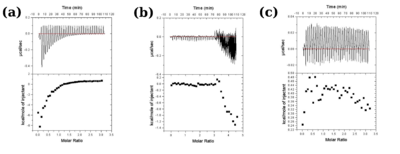Journal:Acta Cryst D:S2059798319004169
From Proteopedia

Structural and functional insights into phosphomannose isomeraseMamata Bangera, Giri Gowda K., S.R. Sagurthi and M.R.N. Murthy [1] Molecular Tour Structure of phosphomannose isomerase from Salmonella typhimurium The : an N terminal α-helical domain, a central catalytic domain and a C terminal domain. The carboxy, catalytic and helical domains are shown in red, green and blue, respectively. The polypeptide fold of the C terminal domain and catalytic domain are very similar to that of the cupin domain found in proteins belonging to different catalytic classes. The central catalytic domain contains the zinc binding site and has longer loops than the C terminal domain Zinc binding site . Mutation in any of these residues interferes with zinc binding, which in turn leads to a non-functional enzyme. Isothermal calorimetric experiments with mutants showed that loss of zinc binding is associated with lack of substrate binding as well. Hence zinc plays an important role in anchoring the substrate in the active site. Active site and catalytic base The colour coding represents conservation of sequence at residue positions, blue representing the least conserved and magenta representing the highly conserved positions. The active site pocket in the centre of the protein colocalises with the bound zinc ion (yellow sphere) and shows highest number of conserved residues. . Zinc ion is shown as a grey sphere in the cupin domain (cartoon representation). Distance between Arg274 and the zinc ion is shown as a dashed line with the distance. In order to determine the most important residues for catalysis, site directed mutagenesis and activity studies were carried out on the mutants. Based on location in active site, conservation across species and complete loss of activity upon mutation, was proposed to be the catalytic base. Concerted movement of residues Lys132 and Arg274 were also identified to be important for the catalytic reaction by this and other studies. However, and the in the native enzyme. Comparison of structures of mutants with native enzyme revealed open and closed conformational states of the enzyme regulated by these residues. These states might be important for the binding of both the open and closed forms of the substrate and product in the catalytic cycle. Two confomational states of StPMI. The loop (G116-H131) and helix (N101-115) occur in 2 orientations in wild type and mutant structures. Representative forms have been shown in red in and . . PDB references: Phosphomannose isomerase from Salmonella typhimurium
References
| |||||||||||


